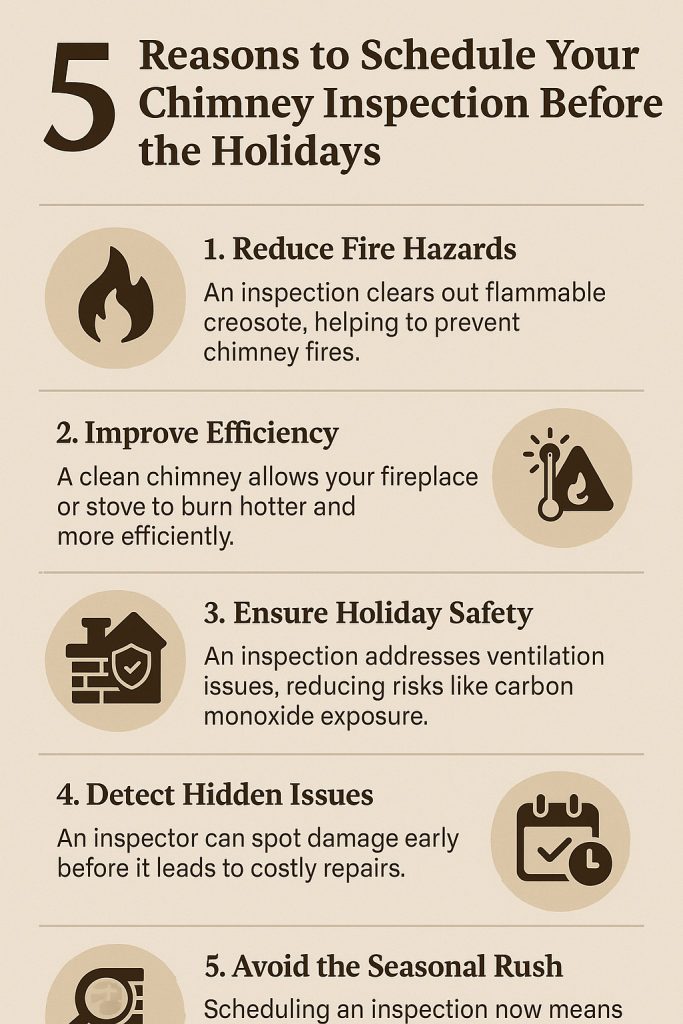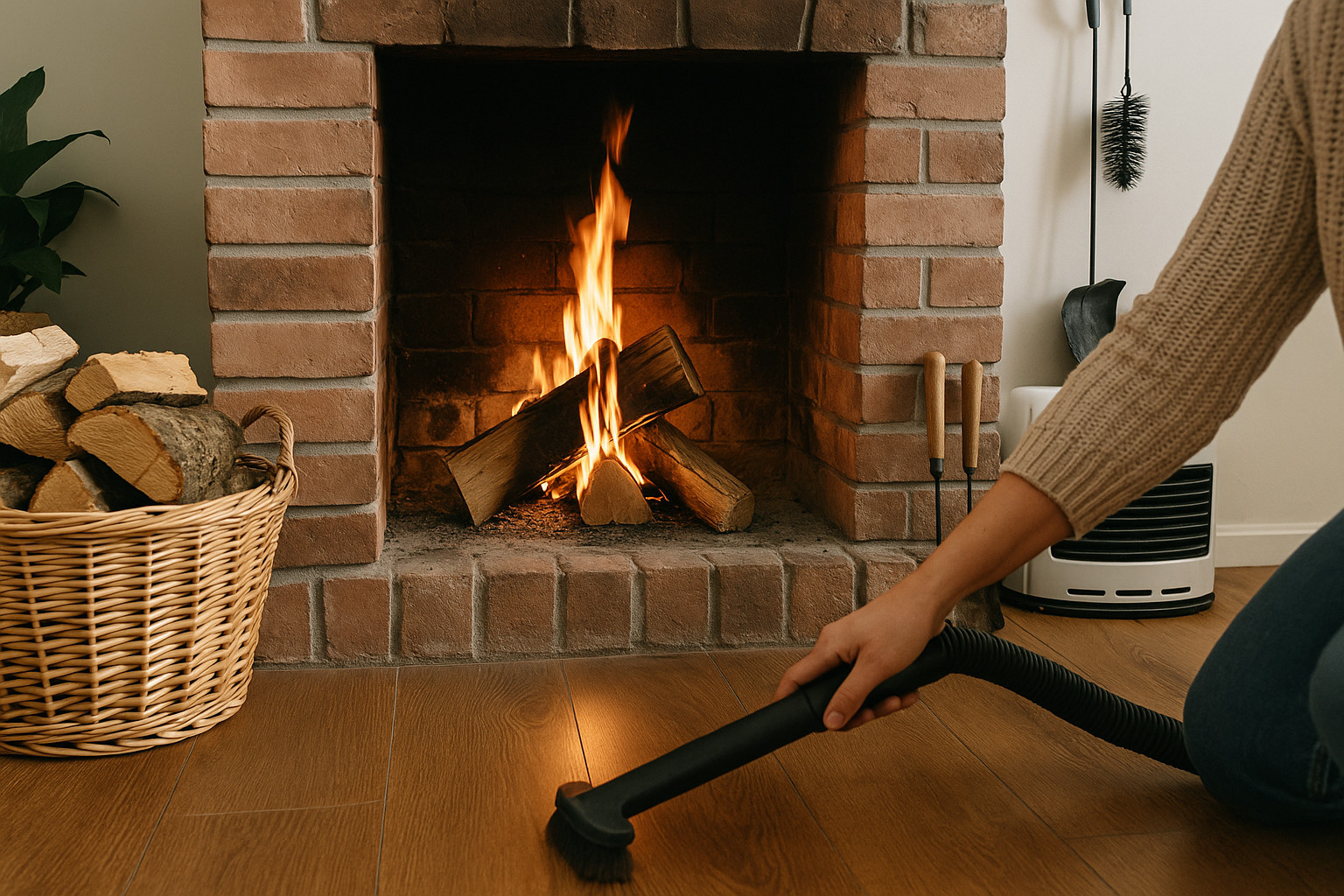Chimney Inspections Before the Holidays: Peace of Mind for Entertaining
Before lighting your first fire of the season, it’s essential to ensure your chimney is safe and ready. Annual inspections help prevent chimney fires, improve heating efficiency, and protect your family from carbon monoxide leaks — giving you peace of mind for a cozy, worry-free holiday season.
Share:
Table of Contents
The Importance of Chimney Inspections
The holiday season is a time for family gatherings, festive meals, and cozy evenings around the fireplace. But before you light that first fire, a chimney inspection should be on your checklist. The National Fire Protection Association (NFPA) recommends annual inspections to reduce fire hazards, identify hidden safety risks, and prevent carbon monoxide leaks. For homeowners in areas like Western New York, where colder weather increases fireplace use, inspections are a critical part of seasonal home maintenance.
Benefits of Pre-Holiday Chimney Inspections
Ensuring Safety During Increased Usage
Fireplaces and stoves see the heaviest use in winter and during holidays. An inspection ensures the chimney flue, smoke chamber, flue liner, and chimney cap are free from creosote buildup, blockages, and water damage. Without proper chimney maintenance, small issues can turn into fire mishaps right when your home is full of guests.
Enhancing Chimney Efficiency
A clean chimney provides better airflow, which means your fireplace or stove burns hotter and more efficiently. This saves energy, reduces smoke inside your home, and prevents heat loss during colder months.
Preventing Fire Hazards
The number one reason for scheduling a chimney inspection before the holidays is to reduce the risk of chimney fires. Creosote, a highly flammable residue, builds up along masonry joints and flue liners. When ignited, it can spread rapidly through the chimney and into the home. A thorough annual cleaning paired with inspection minimizes these risks.
Holiday safety also extends beyond the chimney. Keep flame-resistant decorations away from fireplaces, use a fire screen or fireplace doors, and keep a fire extinguisher within reach. Following fire code NFPA 211 guidelines adds another layer of protection.
Protecting Against Carbon Monoxide Exposure
Carbon monoxide poisoning is a silent but deadly risk associated with poorly maintained chimneys. Cracks in masonry joints, blocked vents, or damaged chimney liners can allow dangerous gases to leak indoors. Installing smoke and carbon monoxide detectors and testing them regularly provides added security, but inspections ensure the source of the problem is addressed.
According to the CDC, hundreds of people die each year from accidental carbon monoxide poisoning, often linked to heating appliances. A pre-holiday chimney inspection significantly reduces this risk.

Early Detection of Chimney Problems
Identifying Hidden Issues
An inspection can uncover structural weaknesses like deteriorating mortar, rusted metal components, or a cracked chimney crown. These problems may not be visible to the homeowner but can compromise home safety if left untreated.
Avoiding Urgent Repairs During the Busy Season
The last thing you want is an emergency call to chimney companies days before guests arrive. Routine inspections allow time for chimney damper repairs, repointing services, or chimney restoration before the holiday rush.
Routine Inspections and Their Long-term Benefits
Maintaining Proper Airflow
Blockages from bird’s nests, holiday wrapping paper tossed into the fire, or debris can reduce airflow. Inspections ensure your chimney sweep clears the path for smoke to exit safely, protecting your HVAC system and maintaining indoor air quality.
Extending Chimney and Fireplace Lifespan
Regular inspections prevent water damage from seeping into masonry construction. Moisture can freeze during winter, expanding cracks and weakening the structure. By catching these issues early, you extend the life of your fireplace, stove, and chimney system.
Timing Your Chimney Inspection
Advantages of Off-Peak Inspections
Fall and winter are peak times for chimney services. Scheduling your inspection in early fall or late summer avoids long wait times and ensures your system is ready before you host holiday gatherings.
Allocating Time for Repairs and Upgrades
If problems are found, like a failing flue liner or corroded damper, an early inspection gives you time to make necessary upgrades. Waiting until December may leave you scrambling for last-minute fixes.
Finding a Qualified Chimney Inspector
Checking Credentials and Certifications
Look for chimney companies with certifications from organizations like the Chimney Safety Institute of America (CSIA). Trained professionals know how to evaluate fire safety hazards, masonry joints, chimney caps, and venting systems thoroughly.
Understanding Inspection Procedures
Chimney inspections come in three levels:
- Level 1: Basic visual check for annual maintenance.
- Level 2: Includes video scan and is recommended before a home sale or after damage.
- Level 3: In-depth inspection requiring partial dismantling when serious issues are suspected.
Knowing what to expect ensures you choose the right inspection for your fireplace needs.
Preparing for the Inspection
What to Expect During the Inspection
A professional will check for creosote buildup, cracks, water damage, smoke chamber integrity, and masonry joints. They may also recommend fireplace cleaning, relining work, or installation and repair services depending on their findings.
Steps to Take Post-Inspection
After the inspection, schedule any recommended repairs immediately. Replace furnace filters, weather stripping, and outdoor lighting as part of your broader home maintenance checklist. This ensures not just your chimney but your entire home is safe and ready for the holiday season.
Conclusion: Peace of Mind for Holiday Entertaining
The holidays should be filled with joy, not worry about chimney fires, carbon monoxide leaks, or safety hazards. By scheduling a chimney inspection before the holidays, you protect your family, your guests, and your home. From preventing fire hazards to catching structural weaknesses early, the benefits far outweigh the cost.
With routine chimney maintenance, annual cleaning, and professional inspections, you can enjoy the warmth of your fireplace or stove without stress. Whether you’re hosting a large family dinner or just decorating the mantle with holiday décor, an inspection provides true peace of mind.
Article details:
- Published by:
- Certified Chimney CT
- Published to:
- Last modified:
- November 3, 2025
Share:



